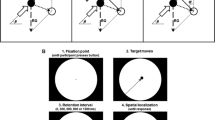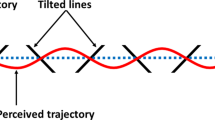Abstract
The visual system is particularly sensitive to the covariation between velocity and curvature that constraint biological motion. Previous work showed that, when this biological constraint is satisfied, simple elliptical motion of a dot looks constant, although its velocity is highly non-uniform. This paper addresses the hypothesis that such a dynamic illusion is dependent upon smooth pursuit eye movements. Subjects had to adjust the kinematics of a dot moving along elliptical trajectories until they perceived a constant velocity. Different pursuit and fixation conditions were tested. The research shows that the dynamic illusion is largely independent of eye movements, suggesting that the visual system has access to implicit knowledge of motor constraints regardless of the concurrent oculomotor commands.
Similar content being viewed by others
References
Beardworth T, Bukner T (1981) The ability to recognize oneself from a video recording of one's movement without one's body. Bull Psychonom Soc 18: 19–22
Bertenthal BI, Proffitt DR, Kramer SJ (1987) Perception of biomechanical motion by infants: implementation of various processing constraints. J Exp Psychol Hum Percept Perform 13: 577–585
Bradley DR, Godiksen EB (1984) The “shrinking circle illusion” is a shrinking ellipse. Perception 13: 207–212
Coren S (1986) An efferent component in the visual perception of direction and extent. Psychol Rev 93: 391–410
Coren S, Bradley DR, Hoenig P, Girgus JS (1975) The effect of smooth tracking and saccadic eye movements on the perception of size: the shrinking circle illusion. Vision Res 15: 49–52
Cutting JE (1981) Coding theory adapted to gait perception. J Exp Psychol Hum Percept Perform 7: 71–87
Festinger L, White CW, Allyn MR (1968) Eye movements and decrement in the Muller-Lyer illusion. Percept Psychophys 3: 376–382
Gauthier GM, de'Sperati C, Tempia F, Marchetti E, Strata P (1995) Eye motion-coding information mediates adaptive modification of vestibulo-ocular reflex in rat. Exp Brain Res (in press)
Grüsser OJ (1986) The effect of gaze motor signals and spatially directed attention on eye movements and visual perception. Prog Brain Res 64: 391–404
Johansson G (1977) Studies on visual perception of locomotion. Perception 6: 365–376
Ludvigh E (1952) Possible role of proprioception in the extraocular muscles. Arch Ophthalmol 48: 436–441
Massey JT, Lurito JT, Pellizzer G, Georgopoulos AP (1992) Three-dimensional drawings in isometric conditions: relation between geometry and kinematics. Exp Brain Res 88: 685–690
Rouanet H, Lecoutre B (1983) Specific inference in ANOVA: from significance tests to Bayesian procedures. B J Math Stat Psychol 36: 252–268
Shepard RN (1984) Ecological constraints on internal representation: resonant kinematics of perceiving, imaging, thinking, and dreaming. Psychol Rev 4: 417–447
Shiffrar M, Freyd JJ (1990) Apparent motion of the human body. Psychol Sci 1: 257–264
Steinbach MJ (1987) Proprioceptive knowledge of eye position. Vision Res 10: 1737–1744
Viviani P, Mounoud P (1990) Perceptuo-motor compatibility in pursuit tracking of two-dimensional movements. J Mot Behav 22: 407–443
Viviani P, Schneider R (1991) A developmental study of the relation between geometry and kinematics in drawing movements. J Exp Psychol Hum Percept Perform 17: 198–218
Viviani P, Stucchi N (1989) The effect of movement velocity on form perception: geometric illusions in dynamic displays. Percept Psychophys 46: 266–274
Viviani P, Stucchi N (1992) Biological movements look uniform: evidence of motor-perceptual interactions. J Exp Psychol Hum Percept Perform 18: 603–623
Viviani P, Terzuolo CA (1982) Trajectory determines movement dynamics. Neuroscience 7: 431–437
Wallach H (1990) The role of eye movements in the perception of motion and shape. In: Kowler E (ed) Eye movements and their role in visual and cognitive processes. Elsevier, Amsterdam, pp 289–305
Author information
Authors and Affiliations
Rights and permissions
About this article
Cite this article
de'Sperati, C., Stucchi, N. Visual tuning to kinematics of biological motion: the role of eye movements. Exp Brain Res 105, 254–260 (1995). https://doi.org/10.1007/BF00240961
Received:
Accepted:
Issue Date:
DOI: https://doi.org/10.1007/BF00240961




